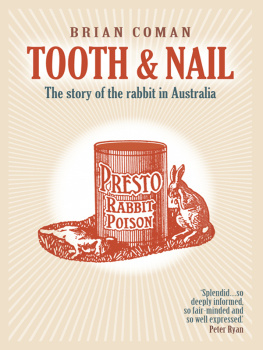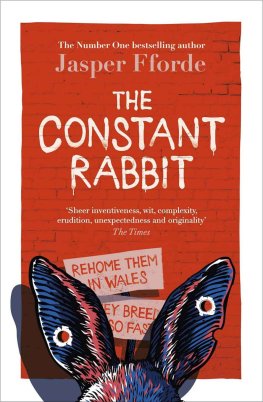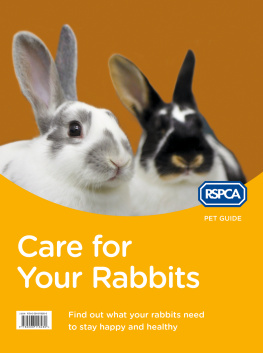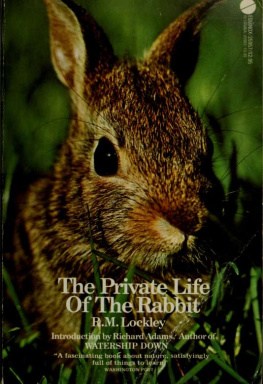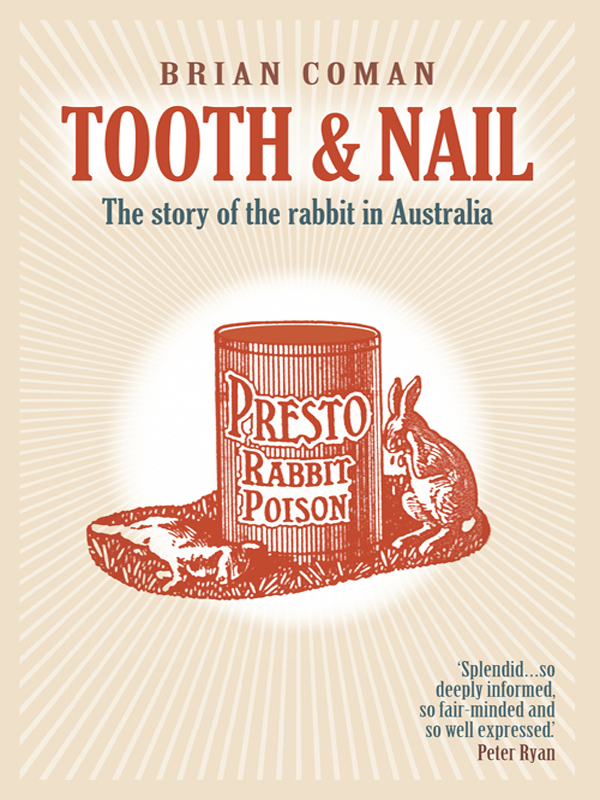
PRAISE FOR Tooth & Nail
Beautifully written and filled with anecdotes collected over a lifetime observing things leporineThe early history of rabbit control in Australia brims with ridiculous schemes and incidents and it is here that Coman excels as a storyteller.
Tim Flannery, Sydney Morning Herald
A wonderful history that will fascinate all readers and inspire those concerned with rabbit control.
Bernard Fennessy
Colourful, clever and richly entertainingan engaging read.
Weekend Australian
An absorbing account of continuing conflict on the Australian landscape.
Geelong Advertiser
Erudite and entertaining.
Canberra Times
In a well-balanced blend of the scientific, the historical, the environmental and the personal, Coman leads us through a sometimes bizarre talewith knowledge, wisdom and good humour.
West Australian.
Brian Coman was born in Victoria in 1944. He was formerly a research scientist in the Victorian Department of Sustainability and Environment and is currently an Honorary Associate in Humanities at LaTrobe University, Bendigo. A collection of his essays titled A Loose Canon was published in 2007.

BRIAN COMAN
TOOTH & NAIL
The story of the rabbit in Australia

TEXT PUBLISHING MELBOURNE AUSTRALIA
ACKNOWLEDGMENTS
I am grateful to the following for permission to adapt maps and diagrams used in this book: Eric Rolls, Eleanor Stodart and Ian Parer, Alan Newsome et al and Environment Australia, John Kovaliski and Brian Cooke.
The paper in this book is manufactured only from wood grown in sustainable regrowth forests.
The Text Publishing Company
Swann House
22 William St
Melbourne Victoria 3000
Australia
textpublishing.com.au
Copyright Brian Coman 1999
All rights reserved. Without limiting the rights under copyright above, no part of this publication shall be reproduced, stored in or introduced into a retrieval system, or transmitted in any form or by any means (electronic, mechanical, photocopying, recording or otherwise), without the prior permission of both the copyright owner and the publisher of this book.
First published by The Text Publishing Company, 1999
This revised an updated edition published 2010
Design by WH Chong and Susan Miller
Typeset by J&M Typesetters
Printed and bound in Australia by Griffin Press
National Library of Australia
Cataloguing-in-Publication data:
Coman, Brian J., 1944
Tooth and nail : a history of the rabbit in Australia / Brian Coman.
ISBN: 9781921656385 (pbk.)
Rabbits--Australia--History. Rabbits--Control--Australia. Agricultural pests--Control--Australia.
632.69320994
CONTENTS
A NOTE ABOUT WEIGHTS,
MEASURES & AREAS
Imperial and metric measurements have been used
throughout this book.
| IMPERIAL | METRIC |
| 1 ounce (oz) | 28.3 grams (g) |
| 1 pound (lb) | 454 grams |
| 1 ton | 1.016 tonnes |
| 1 inch (in) | 2.54 centimetres (cm) |
| 1 foot (ft) | 30.5 cm |
| 1 yard (yd) | 0.914 metres (m) |
| 1 mile | 1.609 kilometre (km) |
| 1 acre (ac) | 0.405 hectare (ha) |
| 1 square mile | 2.59 km2 |
| 1 pint (pt) | 0.568 litre (L) |
| 1 gallon (gal) | 4.55 L |
To my family
I n the decade that has elapsed since the first edition of this book was published, certain predictions made at that time have come to pass but other unforeseen developments have also altered the current situation related to rabbits and their control. Whilst I did suppose, in the first edition, that environmental aspects of rabbit damage would assume greater importance in the future, I could not have predicted the rapid rise to prominence of concerns related to climate change and its implications with respect to rabbit distribution and density. Neither could I have imagined that, at the very same time as these new problems were arising, there would be a fairly general pull-out of research resources dedicated to rabbit damage control in Australia. This is made all the more disturbing by what appears to be a rise in genetic resistance to rabbit haemorrhagic disease. These matters are dealt with in the final two chapters of this new edition. Elsewhere, minor changes have been necessary to update certain specific information but otherwise, the text is substantially unchanged.
There are those who believe that history is a rather subjective businessan ongoing dialogue with the past such that all facts become rather tenuous entities, requiring continuing re-interpretation. I do not share this view. The momentous events consequent upon the introduction of the wild rabbit to southern Australia were the common experience of several generations of mainly rural Australians and it is largely their testimonies that form the history that is related in this book. Part of the job of a historian is to investigate the past on its own terms and that can only be done by respecting the judgments of those who have gone before us. History, in this sense, is like G. K. Chestertons definition of traditionthe democracy of the dead.
The last decade has also seen the passing of a number of people whose contribution to rabbit control in Australia has been momentous. If we were able to see the real environmental gains made as a result of their work, then they would surely be regarded as national heroes. This new edition is dedicated to the memory of two of those people, Bernard Bunny Fennessy and John Bromell.
Perhaps the last word should go to Dionysius of Halicarnassus, who died over 2000 years ago. He proposed that history was philosophy teaching by example. Taking this as our cue we might conclude that the history of human interaction with rabbits in Australia demonstrates one simple philosophical principle related to human behaviourour will to succeed in any endeavour is very often at its lowest ebb when the greatest opportunity for success is within our grasp. Such a situation obtained in the 1950s, after myxomatosis decimated the rabbit population in Australia. This appears to be the case again, post rabbit haemorrhagic disease. It remains for some future chronicler to weigh up the veracity of this principle. For the sake of the Australian environment and for our future farmers, I hope I am proved wrong.
I take delight in history, even its most prosaic details, because they become poetical as they recede into the past. The poetry of history lies in the quasi-miraculous fact that once, on this earth, once, on this familiar spot of ground, walked other men and women, as actual as we are today, thinking their own thoughts, swayed by their own passions, but now all gone, one generation vanishing after another, gone as utterly as we ourselves shall shortly be gone like a ghost at cockcrow. This is the most familiar and certain fact about life, but it is also the most poetical, and the knowledge of it has never ceased to entrance me, and to throw a halo of poetry round the dustiest record that Dryasdust can bring to light.
G. M. Trevelyan
T his is not really a book about rabbits; it is a book about human reactions to rabbits. When I first read Trevelyans marvellous words about history I suddenly realised that you cannot write a history of the rabbit, or for that matter of anything, without relating it directly to human experience. For that reason, you will find very little in this book that discusses the rabbit itselfbreeding, behaviour, population dynamics and other scientific aspects. In this so-called age of science we delude ourselves if we believe that scientific fact takes precedence over human perceptionscience is really just another form of human perception.
Next page
